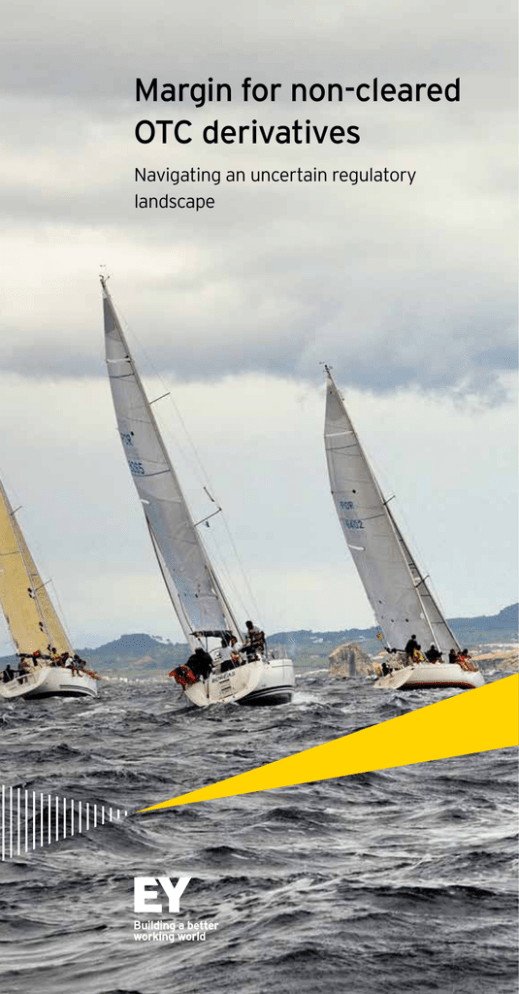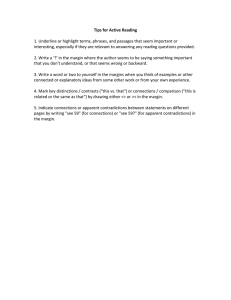
Margin for non-cleared
OTC derivatives
Navigating an uncertain regulatory
landscape
Overview
As part of the Group of 20 (G20)’s commitment to stabilize and protect the financial
system following the crisis in 2008, the Basel Committee on Banking Supervision
(BCBS) and the International Organization of Securities Commissions (IOSCO) created
the Working Group on Margining Requirements (WGMR) to establish global requirements
for margining of non-cleared OTC derivatives.
In September 2013, the WGMR published a final policy framework for non-centrallycleared derivatives. The final framework imposes wide-ranging changes such as the
universal exchange of variation margin (VM) and two-way initial margin (IM), restriction
of eligible forms of collateral to highly liquid assets, segregation for initial margin and
documentation requirements to govern collateral relationships. These requirements will
impact various financial institutions and require front-to-back infrastructure changes.
Since the release of the final margin policy framework, regulators in the United States,
European Union (EU) and Japan have proposed rules principally consistent with the
WGMR final policy framework yet still divergent in key areas, further complicating an
already substantial implementation effort for impacted organizations.
While many impacted organizations have mobilized internal and industry-wide
programs to address these regulations, much uncertainty remains as to whether market
participants can be adequately prepared for the economic and operational impacts of
the new margin regulations.
Global fragmentation
Compliance with VM requirements across all regions will be required starting
December 1, 2015. IM requirements will be phased in based on aggregate gross
notional amounts. The following differences in the proposed regulations will add
to the implementation burden of global institutions.
VM and IM
compliance
schedule
Exceeds
$0 (zero)
€0 (zero)
¥300b
Exceeds
$4t
Exceeds
$3t
Exceeds
$2t
Exceeds
$1t
Exceeds
$3b
€3t
€2.25t
€1.5t
€0.75t
€8b
¥420t
¥315t
¥210t
¥ 105t
¥1.1t
Dec.1, 2015
Dec.1, 2016
Dec.1, 2017
Dec.1, 2018
Dec.1, 2019
Covered
entities
•Financial and systemically important nonfinancial entities are covered.
•EU requires collection of margin from third-country NFC minus1 equivalents.
•US and Japan exempt all nonfinancial entities.
Covered
transactions
•IM and VM are required for all non-cleared OTC derivatives.
•Physically settled FX forwards and swaps are exempt.
•US exempts options on securities (e.g., equity options).
•EU and Japan exempt interaffiliate transactions.
Eligible
collateral
•Cash and highly liquid securities are eligible collateral for IM and VM.
•US requires VM to be cash in US$ or currency of swap obligation.
•EU and Japan impose an 8% haircut for VM when the currencies of the
derivatives transaction and collateral differ.
•EU imposes explicit concentration limits on types of collateral.
IM models
•IM models should cover potential future exposure at the 99% confidence
level over a 10-day liquidation period.
•Netting is permitted within broad risk categories (four in the EU and seven
in the US).
IM segregation
•IM collateral is required to be segregated from proprietary assets.
•US requires segregation at third-party custodians.
•EU and Japan permit other legally effective arrangements.
Documentation
•EU and US define explicit requirements for netting agreements and other
documentation.
•►US requires margin for legacy transactions if under the same master netting
agreement as post-compliance-date transactions.
1 Nonfinancial
counterparties below the clearing threshold.
Industry constraints
Proposed reforms to margining of non-cleared OTC derivatives will impose
significant challenges across all functions of the collateral management life cycle.
• Suppressed implementation timing given the delay in issuance of final rules
• Significant technology, documentation and operational investments to meet the
“big bang” variation margin requirements on December 1, 2015
• Development of criteria to filter and flag in-scope entities and instruments for phasing
in requirements
• Complex front-to-back changes to collateral systems to support multiple agreement
processing (e.g. legacy and post-compliance agreements) with varying margining
mechanics and elections across jurisdictions
• Uncertain process for obtaining regulatory approval of risk-based initial margin
methodologies
• Significant technology changes to implement reconciliation of initial margin attributes
and dispute resolution protocols
• Burdensome documentation requirements and procedural setup due to mandatory
segregation of collateral posted as initial margin
Planning for success
Plans for implementation should include the following key activities in each of the four
following areas:
Program management
•Define governance structure and key stakeholders
•►Develop implementation plans with key projects, milestones
and checkpoints based on known compliance dates
•►Assess timing and resource constraints and define mitigation
•►Mobilize global cross-functional task forces
Client onboarding and information flow
•Analyze existing relationships and identify expected phase-in dates
•►Initiate design of target state data and information flow across systems
•►Develop internal and external communication strategy and approach
for client outreach
Margin methodologies and analytics
•Select an initial margin calculation approach and begin implementation
efforts
•►Document an initial margin calculation methodology, assumptions,
valuation of conceptual soundness and testing procedures
•►Assess integration points with impacted calculations (e.g., capital,
liquidity, funding, pricing, stress testing)
•►Identify necessary attributes to support the dispute resolution process
Collateral management processing
•Conduct an in-house review of key systems and processes;
document target state business and functional requirements
•Design high-level collateral management target state workflow
(including new data fields to be consumed by the system)
•►Assist in developing processes to compute gross notional
calculations to determine expected phase-in year for IM
•Assess the costs of third-party custodian accounts and determine
processing changes required to support third-party segregation
Getting started
Given the complexity of the changes imposed by the global margin regulations,
organizations should begin to mobilize in-house implementation efforts to meet the
rapidly approaching compliance timelines and be responsive to the expectations of
the regulators.
Rules
Regulatory
advocacy
Industry
initiatives
Implementation
plan
Allocate budget
and resources
Prepare and
mobilize crossfunctional team
•Monitor issuance of rules as they become final and prepare for change
based on the proposed rules across jurisdictions
•Maintain active dialogue with regulators via industry forums and
bilateral discussions
•Actively engage in industry initiatives to leverage collective
compliance and standardization efforts
•Establish contingency implementation plans and identify timeline
dependencies to final regulations
•Assess current budget and resource alignment to plan for
upcoming change
•Develop an in-house program and define the governance structure
focusing on implementation efforts across regions
How EY can help
Our approach highlights three progressive phases designed to prepare for global
planning and implementation of the margin requirements. Our methodology takes
into account the nuances of each regulatory jurisdiction to assist institutions in
moving to a globally consistent target operating model.
Program management
1
Plan, scope, and resource management; milestone tracking and internal reporting
2
OTC derivatives
regulatory
rules and
requirements
Readiness assessment
•Global requirements
•Industry leading practices
•Rule management database
•Scoping matrices
Current state
business
processes and
systems
•Rule-based gap assessments►
•Impact assessments across functional areas►
•Tactical and strategic recommendations
•►Enterprise and work-stream-level program road maps
3
Implementation support
Client onboarding
and information flow
•Legal agreements
•Phase-in analysis
•Information flow
•Communication
Margin methodologies
and analytics
•Model build
•Validation
•Regulatory approval
•Pre-trade analytics
•Post trade analytics
Development of
BRDs/FRDs
•Draft targeted
technology and
procedural BRDs
•Draft customized
technology FRDs
•Manage
implementation of
new requirements
Data management
and quality review
•Perform data
quality validation
and testing
•Define change
control
(and testing
procedures)
•Support with data
mapping and data
management
Collateral management
processing
•Collateral data inputs
•Multi-agreement processing
•Collateral eligibility checks
•Segregation
•Portfolio reconciliations
Implementation and
integrity testing
•Design, build and
implement system
changes and
perform testing
•Benchmark
systems and
process to
industry standards
•Design use cases
for testing
Policy and procedure
documentation
•Document rulecompliant policies
and procedures
•Document desklevel procedures
and create
manuals
•Identify control
points and
provide process
enhancements
Contacts
Joe Palumbo
Partner
+1 212 773 3326
joe.palumbo@ey.com
Andrew Lese
Principal
+1 212 773 2070
andrew.lese@ey.com
Andreea Stefanescu
Principal
+1 212 773 6685
andreea.stefanescu@ey.com
Setu Pandya
Senior Manager
+1 416 943 2740
setu.pandya@ca.ey.com
Janina Polo
Senior Manager
+1 212 773 2486
janina.polo@ey.com
John Boyle
Senior Manager
+1 212 773 5412
john.boyle1@ey.com
Why EY
Countries with EY offices
Major financial centers EY has performed G20 derivatives reform projects
• Dedicated global team with capabilities in the Americas, Europe and
Far East focused on G20 derivatives reform including uncleared OTC
margin/collateral reform
• Cross-functional experience implementing collateral management and OTC
derivatives reform across various functional areas including risk, operations
and technology
• Market leader with respect to implementation and program management
for client onboarding, margin analytics and collateral management
EY | Assurance | Tax | Transactions | Advisory
About EY
EY is a global leader in assurance, tax, transaction and advisory
services. The insights and quality services we deliver help build
trust and confidence in the capital markets and in economies the
world over. We develop outstanding leaders who team to deliver
on our promises to all of our stakeholders. In so doing, we play a
critical role in building a better working world for our people, for
our clients and for our communities.
EY refers to the global organization, and may refer to one or
more, of the member firms of Ernst & Young Global Limited,
each of which is a separate legal entity. Ernst & Young Global
Limited, a UK company limited by guarantee, does not provide
services to clients. For more information about our organization,
please visit ey.com.
Ernst & Young LLP is a client-serving member firm of
Ernst & Young Global Limited operating in the US.
© 2014 Ernst & Young LLP.
All Rights Reserved.
Score No. CK0846
1410-1336497
ED 0115
ey.com







